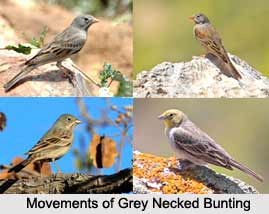 Grey-Necked Bunting or Grey-Hooded Bunting is an Indian bird that bears a scientific name "Emberiza buchanani" found in mountain range of Indian states like Uttar Pradesh, Himachal Pradesh, and the foothills of Shiwalik range.
Grey-Necked Bunting or Grey-Hooded Bunting is an Indian bird that bears a scientific name "Emberiza buchanani" found in mountain range of Indian states like Uttar Pradesh, Himachal Pradesh, and the foothills of Shiwalik range.
Description of Grey-Necked Bunting
Grey-Necked Bunting was described by Edward Blyth based on a drawing by Francis Buchanan-Hamilton after whom the species is named. It has been suggested that the actual date of the description was 1845 due to delays in the publication of the journal of The Asiatic Society, Kolkata.
Category of Grey-Necked Bunting
Grey-Necked Bunting is a species of bird in the Emberizidae family.
Breeding of Grey-Necked Bunting
Grey-Necked Bunting breeds along a wide distribution range from the Caspian Sea to the Altai Mountains in Central Asia and winters in parts of Southern Asia. Like other buntings it is found in small flocks.
Bill of Grey-Necked Bunting
Grey-Necked Bunting has a long pink bill and is greyish above.
Sexes of Grey-Necked Bunting
The male Grey-Necked Bunting has a distinctive white eye-ring that stands out in contrast to the grey hood.
Chin and Throat of Grey-Necked Bunting
The chin and throat of Grey-Necked Bunting are whitish pink and are bordered by grey malar stripes. The under parts are pinkish brown. The female is duller but the moustachial stripe can appear more noticeable. The outer tail feathers are whitish.
Habitat of Grey-Necked Bunting
Grey-Necked Bunting is found mainly in dry and open habitats, often stony, scrubby hillsides covered with low thorn scrub.
Breeding of Grey-Necked Bunting
Grey-Necked Bunting breeds in the Baluchistan region during winter in India moving through Gujarat in September and returning in March to their breeding grounds.
Concentration of Grey-Necked Bunting
Grey-Necked Bunting is found in Afghanistan, Armenia, Azerbaijan, Bhutan, Nepal, China, Hong Kong, India, Iran, Israel, Kazakhstan, Mongolia, Oman, Pakistan, Russia, Syria, Tajikistan, Turkey, Turkmenistan, and Uzbekistan. It is an extremely rare vagrant north of its breeding range, with recent records from Finland and the Netherlands, though wanderers may be overlooked due to its similarity, in non-breeding plumage, to the closely related and far commoner ortolan bunting. They winter in parts of Africa, West Asia, and parts of South Asia as far south as Sri Lanka.
Distribution of Grey-Necked Bunting
The natural habitat of Grey-Necked Bunting is temperate grassland mainly below 7000 ft. In winter it is found in weedy or stubbly fields.
Nests of Grey-Necked Bunting
Grey-Necked Bunting nests on the ground under some overhanging vegetation. The nest is lined with grass and hair. The song given from a perch is a series of short and shrill notes that increase in volume.











